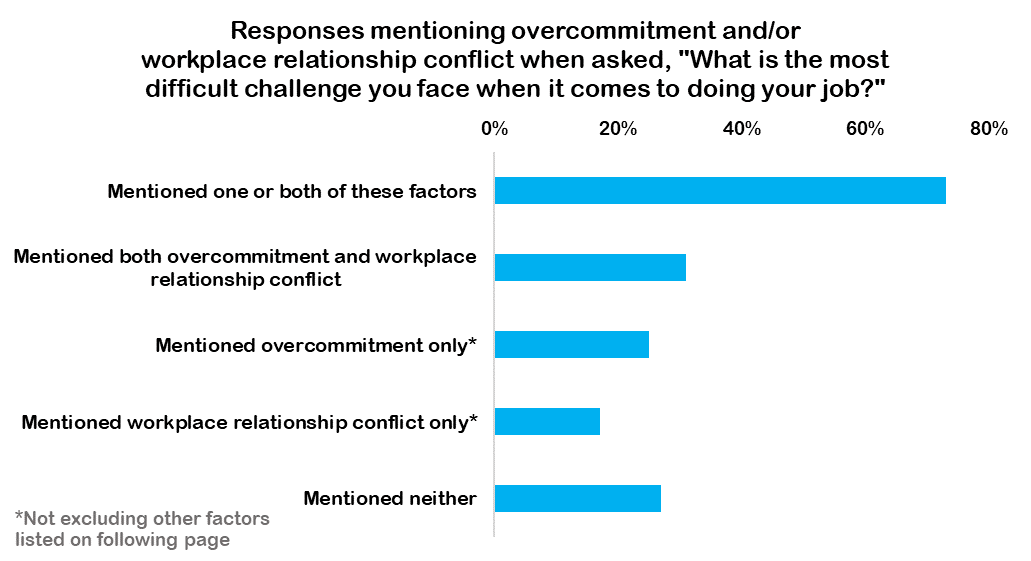TEN YEAR STUDY: TWO DOMINANT CHALLENGES FACING WORKERS PRIOR TO COVID-19 PANDEMIC
[ad_1]
RainmakerThinking has released a new study based on survey data they collected from more than 10,000 working adults in 84 different organizations and of 37 different nationalities during the ten years between the Great Recession to the COVID-19 Pandemic.
New Haven, CT, July 9, 2020—Overcommitment and work relationship conflict were the top two challenges facing workers between March 2010 and March 2020, according to a new study just released by RainmakerThinking, Inc.
This is the latest from RainmakerThinking’s workplace research, ongoing since 1993, which includes data collected from more than 500,000 individuals from more than 400 organizations, and is the basis of numerous studies, hundreds of articles, and 21 books. Their research on the intersection of overcommitment syndrome and relationship conflict at work—and how the most effective people solve that conundrum—is the basis of Tulgan’s new book, THE ART OF BEING INDISPENSABLE AT WORK: Win Influence, Beat Overcommitment, and Get the Right Things Done, to be published by Harvard Business Review Press in July.
In this new study, RainmakerThinking examined open ended response data collected between March 2010 (the end of the Great Recession) and March 2020 (the emergence of the COVID-19 Pandemic) in response to the question, “What is the most difficult challenge you face when it comes to doing your job?”
56% of respondents cited some form of overcommitment
48% cited some form of workplace relationship conflict
31% mentioned both overcommitment and workplace relationship conflict
73% mentioned at least one or both factors; only 27% mentioned neither
These numbers remained surprisingly consistent across a wide range of employees in various roles and levels in organizations of different shapes and sizes and industries.
Tulgan says, “These deeply intertwined problems of overcommitment and relationship conflict have been rising to the top, not just in this study, but in all of our research, training and consulting, more and more, over the last ten years. My search for solutions led me over and over to people who remain consistently in great demand without succumbing to overcommitment syndrome, those I refer to as ‘go-to people.’ I kept trying to figure out, ‘How do they do that?’ Figuring out how these real ‘go-to people’ stand the test of time is what led me ultimately to write the new book.”
“It is a constant theme in business, but especially since the Great Recession, organizations have been determined to get more and more work out of every employee,” Tulgan says. “Organizations have not only steadily increased everybody’s individual workload, but they have also been streamlining work by pushing increased collaboration. That means everybody is dealing with a lot more people—and all these people are almost always making requests of each other.”
What Tulgan saw, again and again, was a tendency for people—trying to be good team players and prove their value—to manage these relationships by overcommitting themselves, saying “yes” to every new ask or project, even if they didn’t have the bandwidth. Even before the Pandemic hit, when unemployment was at record lows, most employees didn’t want to give the impression they were not pulling their weight. Says Tulgan, “That is doubly true now, with so many people so worried about their job security.”
“The irony is that people who allow themselves to become overcommitted end up either dropping balls and letting people down or start to suffer from what I call ‘siege mentality’ and start hiding from everyone and everything at work. Either way, their overcommitment ends up causing conflict in their work relationships.”
The go-to people Tulgan has studied, whose way of thinking and conducting themselves form the basis of his new book, are not just “yes” people. “The reason why people ‘go to’ them over and over again is not that they say yes to everyone and everything. Rather, they play a longer game of service,” Tulgan says. These go-to people serve others more and better, add more value for more people consistently over time, and thus are the most relied upon by their peers. How? By pacing themselves, slowing down to make sure they do the right things in the right order for the right reasons, every step of the way.
Says Tulgan, “These go-to people realize that, if you are truly committed to service, you don’t burn yourself out because then you will be of no service to anyone, at least for some period of time. In fact, you will likely require the services of others.”
How do you make yourself truly indispensable at work in the post-pandemic world? Says Tulgan, “The way to add the most value for the most people consistently over time is to play the long game of service, one moment at a time. That is how you beat overcommitment, avoid relationship conflict, and win real influence so that everybody wants to work with you and nobody would want to work without you. That’s what the book is all about.”
Learn more about RainmakerThinking’s ten year study and their findings on their website.
Bruce Tulgan’s The Art of Being Indispensable at Work is due for release July 21, 2020 from Harvard Business Review Press and available for pre-order now from all major booksellers.

